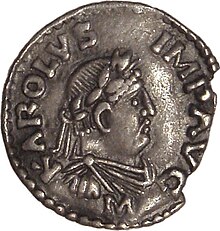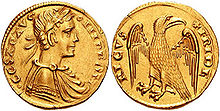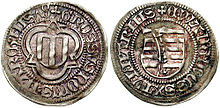Medieval coins

Medieval coins are known from different regions of the world. The European medieval coins were based on the Roman currency of antiquity. The Roman coins also received their impulses from ancient Greek coins . The Byzantine coins developed from both roots in the early Middle Ages . Islamic coins were influenced by ancient Greek and Roman coins, but as purely written coins with Arabic script and without pictorial motifs, they had a completely different appearance.
European coins of the Middle Ages

From late antiquity to the early Middle Ages , the circulation of coins in Europe declined sharply. The bartering increased and more financial transactions were often paid in bullion metal. The few coins were mostly copies of the Roman models . The coin orders of the various rulers usually only stipulated how heavy the individual coins should be; they did not change the design. In the Frankish empire and its successor empires ( France , Eastern Franconia ) the denarius or pfennig was the almost exclusively minted coin (see Carolingian coin system ). However, the originally royal minting law in the Holy Roman Empire expanded increasingly to include other secular and spiritual rulers, which resulted in a multitude of different versions of the pfennig ( regional pfennig since the 12th century) and a general reduction in the silver content of the coins. In the 10th and 11th centuries, an independent coin tradition began in Eastern Europe.

From the middle of the 12th century to the 14th century, bracteates were the predominant type of coin in almost all of the German-speaking countries (with the exception of the Rhineland) . These thin silver penny coins, embossed on one side, continued the process of weight loss of the old pennies. With the thinness of the coins, however, the diameter increased, which temporarily offered the opportunity for a more artistic design of the coin images. Images of rulers remained dominant, but other motifs also appeared increasingly. For the Thuringian landgraves, the Reiterbrakteat of the Eisenach and Gotha mints from around 1150 to 1247, minted under the Ludowingers and from 1247 to around 1290 under the Wettins after the unification of Meissen and Thuringia, is the typical pfennig coin. In the late Middle Ages , however, the design of the bracteates also deteriorated. In some Swiss cantons brakteatenartige were until the 18th century centimes , Haller and angster made. From time to time bracteates were “ disreputable ”, ie declared invalid and demanded back from the minters in order to exchange them for a smaller amount of new coins. The discount could be up to 25%. This was a common form of tax collection at the time. Since such denunciations of coins followed one another ever more quickly, there was resentment and the call for permanent money, a so-called "eternal penny" . This led to the abandonment of the bracteates.
The first European coin to show a year is a penny from Roskilde , Denmark. The coin with the year 1234 (ANNO DOMINI MCCXXXIIII) was probably issued by Bishop Niels Stigsen as a souvenir of the special sequence of numbers for the year of issue. It wasn't until 138 years later that coins with dates were minted again. The oldest dated German coins are groschen from Reinhard von Schönforst (1369–1396) from the Jungheit vor Aachen mint from 1372.


Gold coins were rarely struck in the early and high Middle Ages . Among the most splendid are the Augustals of Frederick II. It was not until the 13th century that gold coins were increasingly struck. This development came from the Italian trading cities, above all Florence with the Florens and Venice with the ducats (also called Zechinen ), which were first minted in 1284 . Due to the economic influence of the cities, the coins spread quickly and many rulers took them as a model for their own minting. In France and England gold coins were more common and the individual pieces were significantly larger than in the empire. As a further development in the 13th century, the Groschen appeared in Germany as a larger silver coin. For the first time, the coin images of the groschen also increasingly showed princes of the respective territory. Overall, the artistry of the embossing increased again. Gothic style elements were evident on the coins.
The year 1356 was a decisive date in German minting law , when the emperor expressly recognized the elector's minting right with a “ Golden Bull ” . Previously, the imperial-free city of Lübeck was granted the first to mint gold guilders in 1340 . From this point in time until 1871, the history of coins in Germany was characterized by great diversity, as many countries issued their own money.
Knowledge of the significance of the coins is of great use in archaeological research, as layers excavated through the coins can be dated relatively accurately.
Here are some names that were used in the Middle Ages:
- Heller : Until the introduction of the mark, the Heller was the smallest coin. The Heller was minted around 1200 in Schwäbisch Hall, from which its name is derived.
- Penny or denarius
- Kreuzer : The cruiser got its name from the double cross on the front. It was abolished when the currency was changed in 1873.
- Schilling or groschen
- Chunk
- Pound (origin of the name of the weight unit, see Karl pound ) or also: ( Florentine ) Gulden (name of the material)
In other countries too:
- Ducats (name from Latin dux, ducis, the prince)
- Louis d'or (France, name after King Ludwig; made of gold)
Definitely no values can be given, since the precious metal content fluctuated strongly when the coins were minted, i.e. in practice it decreased over time. The owners of the local minting right melted down foreign high-quality coins in order to mint their own coins with reduced fineness. The mint right holder was able to reap the difference between the silver or gold content known up to that point in time to the new lower value as a profit.
The purchasing power of coins also fluctuated considerably as a result of economic success and crisis, wars and epidemics. (See also " Böse Halser ", spoils of late medieval inflation.)
The conversion table is only intended to give an indication of the relative values of the coins. Since there were a variety of currencies, there were also different conversion systems. The taler could have a value of 20 to 48 shillings or groschen, while the groschen was sometimes worth more or less than 12 pfennigs, the taler could also be equivalent to a gulden, etc.
| Coin or bill coin | corresponds | in penny |
|---|---|---|
| Brighter | ½ | |
| Penny (denarius) | 2 lighter | 1 |
| cruiser | 4th | |
| Schilling (solidus), groschen | 3 cruisers | 12 |
| Chunk | 4 cruisers | 16 |
| Pounds, guilders | 20 shillings | 240 |
| Valleys | 30 shillings | 360 |
See also
- Coin law , German coins , Carolingian coin system , money system of the Faroe Islands in the Middle Ages , Lübeck coin history , Wendischer Münzverein , Mecklenburg coin history
- Saxon coin history / Bracteate time / Grosch time
- Bracteates (Dohna)
- Margarethe dime , Bart dime , Sachsen Pfennig , Otto-Adelheid-Pfennig , Perpetual penny
- Freiberg Mint / Bracteate Age / Groschen Time
- Colditz Mint / Bracteate Age / Groschen Age
- Mint Gotha / Bracteatenzeit / Groschenzeit
- Mint Langensalza / Bracteatenzeit / Groschenzeit
- Sangerhausen Mint / The coins of the mint
- Mint Schneeberg / Groschenzeit
- Weimar Mint / Bracteaten Era / Groschen Era
- Mint Wittenberg / Bracteatenzeit / Groschenzeit
- Zwickau Mint / Groschenzeit
literature
- Philip Grierson : Coins of the Middle Ages . German translation by Alfred P. Zeller , Battenberg, Munich 1976 (= The World of Coins , 4)
- Norbert Kamp: Moneta regis. Royal mints and royal minting policy in the Staufer period . Hahnsche Buchhandlung, Hannover 2006, ISBN 3-7752-5755-1 .
- Bernd Kluge: German coin history from the late Carolingian era to the end of the Salians . Jan Thorbecke Verlag, Sigmaringen 1991, ISBN 3-7995-4139-X .
- Bernd Kluge: Numismatics of the Middle Ages . Publishing house of the Austrian Academy of Sciences, Berlin and Vienna 2007, ISBN 978-3-88609-603-9 .
- Jacques Le Goff : Money in the Middle Ages . German translation by Caroline Gutberlet, Klett-Cotta, Stuttgart 2011, ISBN 978-3-608-94693-2
- Hendrik Mäkeler: Imperial coinage in the late Middle Ages, Part 1: The 14th century . Franz Steiner Verlag, Stuttgart 2010, ISBN 978-3-515-09658-4 .
- Heinrich Troe: Coin, customs and market and their financial significance for the empire from the exit of the Hohenstaufen to the accession of Charles IV. A contribution to the history of the imperial financial system in the period from 1250 to 1350 . Verlag W. Kohlhammer, Stuttgart and Berlin 1937.
Web links
Individual evidence
- ^ Levinson, Robert A.: The early dated coins of Europe, 1234-1500 . Coin and Currency Institute, Clifton, NJ 2007, ISBN 978-0-87184-600-6 .
- ↑ Helmut Kahnt: Das große Münzlexikon von A to Z (2005), p. 208